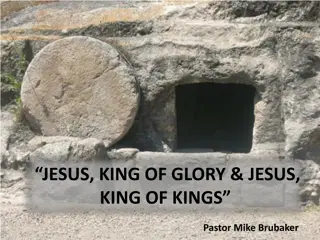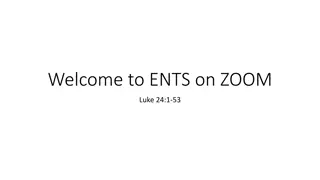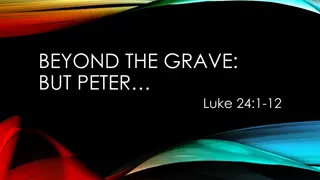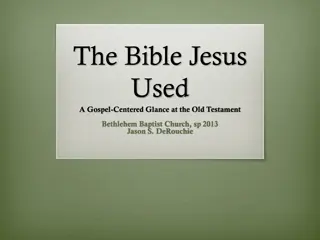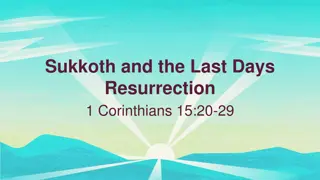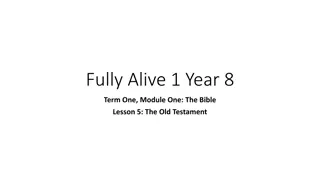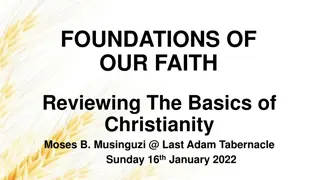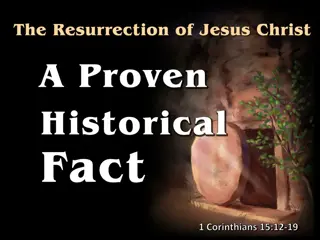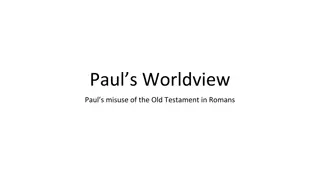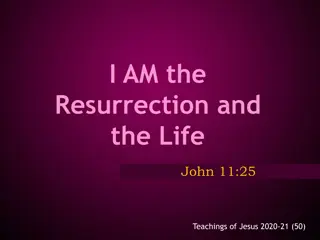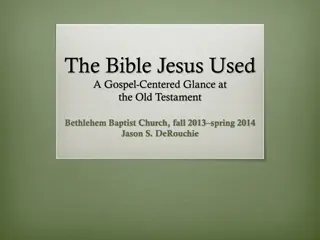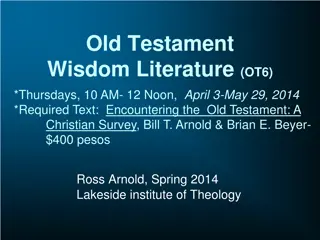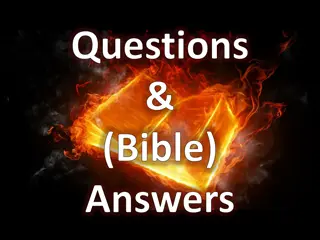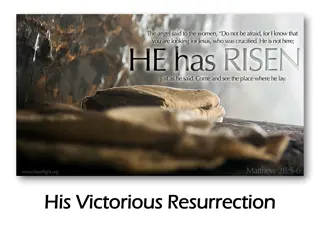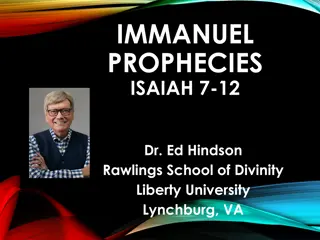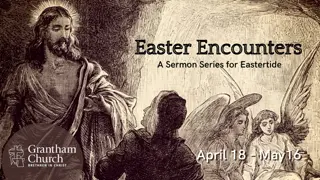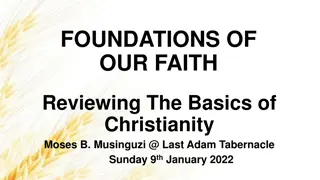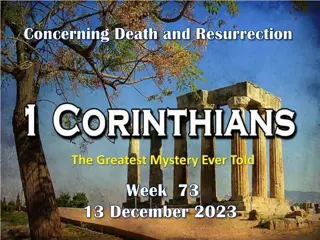Understanding Resurrection According to the New Testament
Exploring the concept of resurrection as outlined in the New Testament, distinguishing it from resuscitation, reanimation, reincarnation, and immortality. Delve into the direction of intention prayer and the Old Testament's perspective on life after death.
Download Presentation

Please find below an Image/Link to download the presentation.
The content on the website is provided AS IS for your information and personal use only. It may not be sold, licensed, or shared on other websites without obtaining consent from the author. Download presentation by click this link. If you encounter any issues during the download, it is possible that the publisher has removed the file from their server.
E N D
Presentation Transcript
The Resurrection of Jesus as Outlined in the New Testament
The Direction of Intention Prayer My God, give me the grace to perform this action with you and through love for you. In advance, I offer to you all the good that I will do and accept all the difficulty I may meet therein. St. Ann, Pray for Us St. Francis de Sales, Pray for us
Helpful Terms and Definitions Resurrection - a transition from mortal life on earth, through physical death, to a new, completely different, form of immortal life. Resurrection is not the same as the "resuscitation" or "reanimation" of a body, nor the "reincarnation" or "immortality" of a soul.
Helpful Terms and Definitions Resuscitation - the restoration or revival of a person from a coma, unconsciousness, or apparent death back to the same earthly life. Reanimation - the rejoining of an earthly body with the same soul (or a new soul?) after a temporary separation. Reincarnation - the rebirth of a soul into a new & different but still physical & mortal body (common idea in some Eastern religions). Immortality - the inability to die; life continuing forever (esp. a soul after its separation from a dead body)
Overview Old Testament development of resurrection Earliest writings in the New Testament about Resurrection What really happened? Themes from the Resurrection Accounts from the Gospels The Resurrected BODY of Jesus
Old Testament Development of Resurrection Earliest Stages in OT: No belief in life after death whatsoever; life simply ceases to exist Psalm 115:17 - "The dead do not praise the Lord, nor do any that go down into silence. Ecclesiastes 9:5 - "The living know that they will die, but the dead know nothing; they have no more reward, and even the memory of them is lost. Job 7:9 - "As the cloud fades and vanishes, so those who go down to Sheol do not come up"
Old Testament development of resurrection Middle Stages in OT: Belief in a general resuscitation or reanimation of many of the dead, or the whole nation, to a renewed life on earth: Isaiah 26:19 - "Your dead shall live, their corpses shall rise. O Dwellers in the dust, awake and sing for joy! Ezekiel 37 - Ezekiel's Vision of the Valley Full of Dry Bones, coming back to life with God's Spirit breathed into them. Daniel 12:2 - "Many of those who sleep in the dust of the earth shall awake, some to everlasting life, and some to shame and everlasting contempt."
Old Testament development of resurrection Latest Stages in OT: Beginning beliefs in continued life after death and/or resurrection from the dead for individuals: Wisdom 3:1-8 - "But the souls of the righteous are in the hand of God... In the eyes of the foolish they seemed to have died... but they are at peace... their hope is full of immortality Maccabees 7:14 - "One cannot but choose to die at the hands of men and to cherish the hope that God gives of being raised again by him. 2 Maccabees 12:43-45 - "...taking account of the resurrection. For if he were not expecting that those who had fallen would rise again, it would have been superfluous and foolish to pray for the dead. But if he was looking to the splendid reward that is laid up for those who fall asleep in godliness, it was a holy and pious thought."
Earliest writings in the New Testament about Resurrection NT Developments: Belief in resurrection from death to a new and different form of life: 1 Cor 15:35-57 - Paul explains that the spiritual imperishable body will be different from the physical perishable body, as a plant differs from a seed. If Christ has not been raised from the dead then EMPTY is your faith and EMPTY is our preaching Romans 6:9 For we know that since Christ was raised from the dead, he cannot die again; death no longer has mastery over him. (Galatians 1:1; Romans 4:24; Ephesians 1:20) It was God who raised Jesus from the dead
What really happened? Mark Matthew Luke John Women Find Jesus' Tomb Empty Peter and the Beloved Disciple Run Jesus Appears to the Women The Guards Report back to the Authorities Emmaus Jesus Appears Evening in Jerusalem 20:19-23 Jesus Appears a Week Later (with Thomas)-- Jesus Appears to the Eleven as They Sat at [16:14-18] -- Mountain in Galilee (The Great Commission) 28:16-20 His Ascension to Heaven, from Bethany -- Jesus Appears at the Sea of Tiberius The Second Ending of John 16:1-8 -- [16:9-11] 28:9-10 -- -- [16:12-13] -- -- -- 28:1-8 24:1-11 -- 20:1-2, 11-13 20:2-10 20:14-18 24:12 28:11-15 -- 24:13-35 -- 24:36-43 -- -- -- 20:24-29 -- -- 24:44-53 -- -- [16:19-20] -- -- -- -- -- -- -- 21:1-23 21:24-25
Significance of the Empty Tomb Center of the Christian Faith The Fulfillment of Scripture (Old Testament) God s vindication of His Chosen One Psalms and Prophets Basis of Apostolic Preaching (Death, Burial, Resurrection) Peter s speeches in Acts Faith Statement v. Historical Scientific statement Believers understood the significance of what had taken place in time and to the body of Jesus (he saw and believed) It animated the lives of early Christians to the point that they were willing to die
The Resurrected Body of Jesus The Women saw a body (person); a physical being Jesus appearance was recognizable but not easily grasped Mary Magdalene Disciples on the way to Emmaus Peter and others on the Boat Jesus on the shore Sea of Galilee Jesus bore the marks of his Crucifixion Not just Thomas but all who saw him (implied that all who saw the Risen Jesus recognized that the marks were indeed visible. Jesus ate and drank Cooks Jesus body although physically identifiable was not bound by physical reality Appears in locked room Disappears from their midst Ascension: taken from their sight





